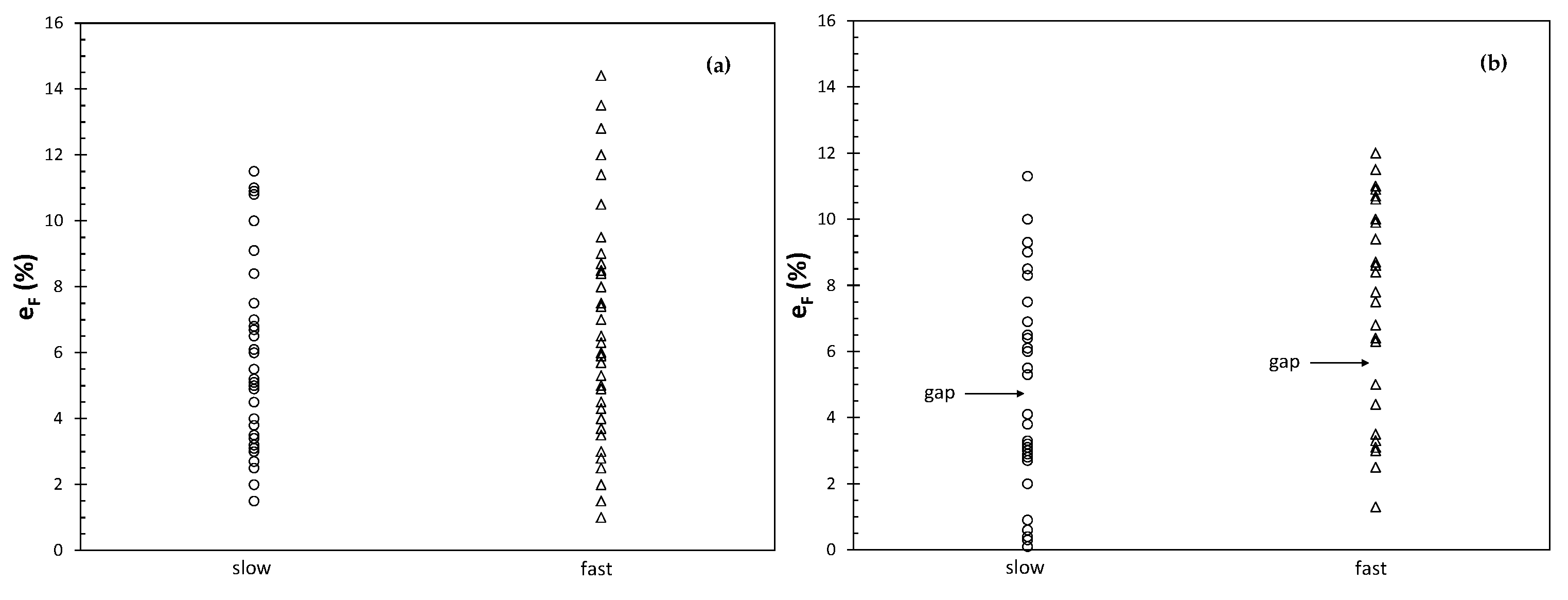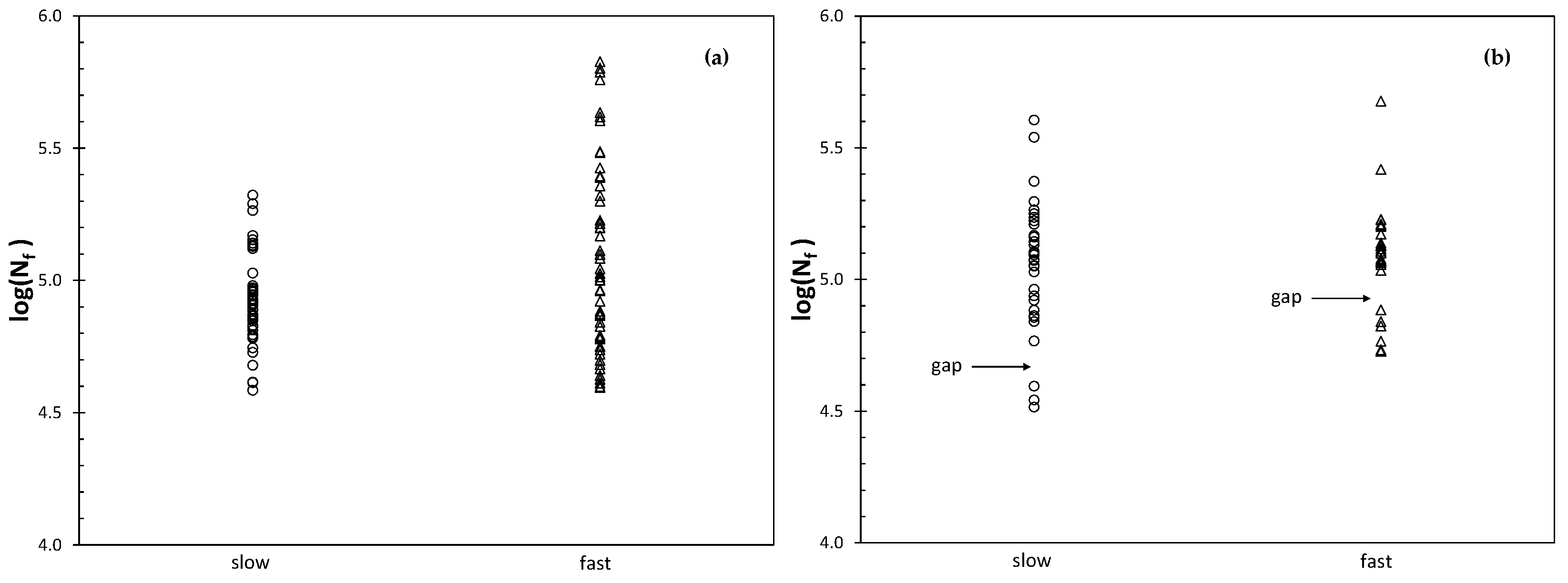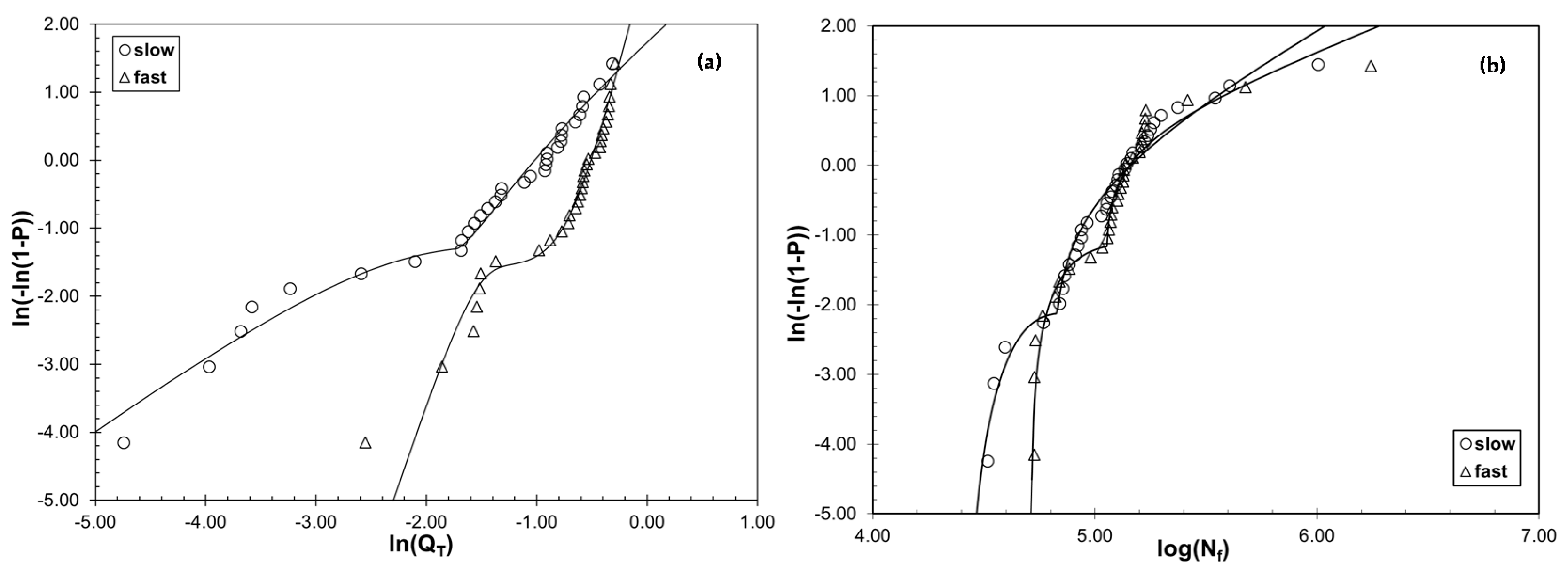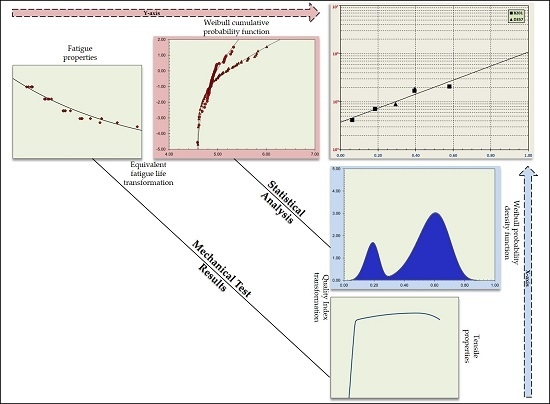On the Relationship between Structural Quality Index and Fatigue Life Distributions in Aluminum Aerospace Castings †
Abstract
:1. Introduction
2. Materials and Methods
2.1. Experiments by Ozelton et al.
2.2. Statistical Analysis
3. Results
4. Discussion
- the original rather fine scattering of defects remaining in suspension in the original poured liquid from the crucible or ladle (prior damage). These “old” bifilms have a typical minimum thickness of approximately 10 μm and show only coarse wrinkles.
- the large new bifilms (new damage) that would have been produced during the melt transfer and/or pouring and filling if the filling system was not designed properly. These “young” oxides have a minimum thickness of tens of nanometers or less and show fine wrinkles on fracture surfaces of castings.
5. Conclusions
- The quality index, QT, can be used to characterize the structural integrity of D357 and B201 aluminum alloy castings.
- Probability plots for both QT and Nf distributions for B201 showed strong indications of Weibull mixtures.
- There is a strong relationship between the mean QT and Nf values as calculated from estimated Weibull parameters.
- There is a strong negative correlation between the proportion of QT in Region 1 and probability of survival for 105 cycles. Similarly, a strong positive correlation exists between the proportion of QT in Region 3 and probability of survival for 105 cycles, providing further evidence for the strong link between elongation and fatigue performance.
- The statement that the elongation requirement in industrial specifications is a de facto fatigue life specification is justified.
Author Contributions
Conflicts of Interest
Nomenclature
| β0, β1 | alloy dependent constants |
| f | Weibull probability density function |
| Γ | gamma function |
| m | shape parameter |
| σ | mean value of the Weibull distribution |
| Nf | fatigue life |
| σ0 | scale parameter |
| p | fraction of the lower distribution |
| σT | threshold value below which no failure is expected |
| P | probability of failure |
| σY | yield strength (MPa) |
| PL | probability from lower distribution |
| eF | elongation |
| PU | probability from upper distribution |
| eF(max) | maximum elongation, ductility potential |
| QT | quality index |
References
- MIL-A-21180 D: Aluminum-Alloy Castings. Available online: http://everyspec.com/MIL-SPECS/MIL-SPECS-MIL-A/MIL-A-21180D_6087/ (accessed on 1 April 2016).
- Dieter, G.E. Mechanical Metallurgy; McGraw-Hill: New York, NY, USA, 1976. [Google Scholar]
- Reed-Hill, R.E. Physical Metallurgy Principles; Van Nostrand: Princeton, NJ, USA, 1964. [Google Scholar]
- Green, N.R.; Campbell, J. Statistical distributions of fracture strengths of cast Al-7Si-Mg alloy. Mater. Sci. Eng. A 1993, 173, 261–266. [Google Scholar] [CrossRef]
- Nyahumwa, C.; Green, N.R.; Campbell, J. Influence of casting technique and hot isostatic pressing on the fatigue of an Al-7Si-Mg alloy. Metall. Mater. Trans. A 2001, 32, 349–358. [Google Scholar] [CrossRef]
- Lee, C.D.; Shin, K.S. Effect of microporosity on the tensile properties of AZ91 magnesium alloy. Acta Mater. 2007, 55, 4293–4303. [Google Scholar] [CrossRef]
- Lee, C.D. Effect of grain size on the tensile properties of magnesium alloy. Mater. Sci. Eng. A 2007, 459, 355–360. [Google Scholar] [CrossRef]
- Tiryakioğlu, M. On estimating the fracture stress and elongation of Al–7%Si–0.3%Mg alloy castings with single pores. Mater. Sci. Eng. A 2010, 527, 4546–4549. [Google Scholar] [CrossRef]
- Song, J.; Xiong, S.M.; Li, M.; Allison, J. In situ observation of tensile deformation of high-pressure die-cast specimens of AM50 alloy. Mater. Sci. Eng. A 2009, 520, 197–201. [Google Scholar] [CrossRef]
- Staley, J.T., Jr.; Tiryakioğlu, M.; Campbell, J. The effect of hot isostatic pressing (hip) on the fatigue life of A206-T71 aluminum castings. Mater. Sci. Eng. A 2007, 465, 136–145. [Google Scholar] [CrossRef]
- Tiryakioğlu, M.; Campbell, J.; Alexopoulos, N.D. Quality indices for aluminum alloy castings: A critical review. Metall. Mater. Trans. B 2009, 40, 802–811. [Google Scholar] [CrossRef]
- Tiryakioğlu, M.; Campbell, J.; Alexopoulos, N.D. On the ductility of cast Al-7 pct Si-Mg alloys. Metall. Mater. Trans. A 2009, 40, 1000–1007. [Google Scholar] [CrossRef]
- Tiryakioğlu, M.; Campbell, J. Quality index for aluminum alloy castings. Int. J. Met. 2015, 8, 39–42. [Google Scholar] [CrossRef]
- Tiryakioglu, M.; Campbell, J. Quality index for aluminum alloy castings. AFS Trans. 2013, 13, 217–222. [Google Scholar] [CrossRef]
- Tiryakioğlu, M.; Campbell, J.; Nyahumwa, C. Fracture surface facets and fatigue life potential of castings. Metall. Mater. Trans. B 2011, 42, 1098–1103. [Google Scholar] [CrossRef]
- Alexopoulos, N.D.; Tiryakioğlu, M. On the uniform elongation of cast Al–7%Si–0.6%Mg (A357) alloys. Mater. Sci. Eng. A 2009, 507, 236–240. [Google Scholar] [CrossRef]
- Tiryakioğlu, M. On the relationship between elongation and fatigue life in A206-T71 aluminum castings. Mater. Sci. Eng. A 2014, 601, 116–122. [Google Scholar] [CrossRef]
- Ozelton, M.; Mocarski, S.; Porter, P. Durability and Damage Tolerance of Aluminum Castings. Available online: http://www.dtic.mil/dtic/tr/fulltext/u2/a245237.pdf (accessed on 1 April 2016).
- Weibull, W. A Statistical Theory of the Strength of Materials; Generalstabens litografiska anstalts förlag: Stockholm, Sweden, 1939. [Google Scholar]
- Weibull, W. The Phenomenon of Rupture in Solids; Generalstabens litografiska anstalts förlag: Stockholm, Sweden, 1939. [Google Scholar]
- Weibull, W. A statistical distribution function of wide applicability. J. Appl. Mech. 1951, 18, 293–297. [Google Scholar]
- Peirce, F.T. Tensile tests for cotton yarns–“the weakest link” theorems on the strength of long and of composite specimens. J. Text. Inst. Trans. 1926, 17, T355–T368. [Google Scholar]
- Tiryakioglu, M.; Campbell, J. Ductility, structural quality, and fracture toughness of Al–Cu–Mg–Ag (A201) alloy castings. Mater. Sci. Technol. 2009, 25, 784–789. [Google Scholar] [CrossRef]
- Anderson, T.W.; Darling, D.A. A test of goodness of fit. J. Am. Stat. Assoc. 1954, 49, 765–769. [Google Scholar] [CrossRef]
- Tiryakioğlu, M.; Campbell, J. Weibull analysis of mechanical data for castings: A guide to the interpretation of probability plots. Metall. Mater. Trans. A 2010, 41, 3121–3129. [Google Scholar] [CrossRef]
- Tiryakioğlu, M. Weibull analysis of mechanical data for castings ii: Weibull mixtures and their interpretation. Metall. Mater. Trans. A 2015, 46, 270–280. [Google Scholar] [CrossRef]
- Jiang, S.; Kececioglu, D. Maximum likelihood estimates, from censored data, for mixed-weibull distributions. IEEE Trans. Reliab. 1992, 41, 248–255. [Google Scholar] [CrossRef]
- Staley, J.T., Jr.; Tiryakioğlu, M.; Campbell, J. The effect of increased hip temperatures on bifilms and tensile properties of A206-T71 aluminum castings. Mater. Sci. Eng. A 2007, 460–461, 324–334. [Google Scholar] [CrossRef]
- Campbell, J. Castings, 2nd ed.; Elsevier: Oxford, UK, 2003. [Google Scholar]
- Campbell, J. Entrainment defects. Mater. Sci. Technol. 2006, 22, 127–145. [Google Scholar] [CrossRef]
- Wang, Q.G.; Crepeau, P.N.; Davidson, C.J.; Griffiths, J.R. Oxide films, pores and the fatigue lives of cast aluminum alloys. Metall. Mater. Trans. B 2006, 37, 887–895. [Google Scholar] [CrossRef]
- Nyahumwa, C.; Green, N.; Campbell, J. Effect of mold-filling turbulence on fatigue properties of cast aluminum alloys (98–58). Trans. Am. Foundrymen’s Soc. 1998, 106, 215–223. [Google Scholar]
- Zhang, B.; Poirier, D.R.; Chen, W. Microstructural effects on high-cycle fatigue-crack initiation in A356.2 casting alloy. Metall. Mater. Trans. A 1999, 30, 2659–2666. [Google Scholar] [CrossRef]
- Eisaabadi B, G.; Davami, P.; Kim, S.K.; Tiryakioğlu, M. The effect of melt quality and filtering on the weibull distributions of tensile properties in Al–7%Si–Mg alloy castings. Mater. Sci. Eng. A 2013, 579, 64–70. [Google Scholar] [CrossRef]
- Wang, Q.G.; Apelian, D.; Lados, D.A. Fatigue behavior of A356-T6 aluminum cast alloys. Part i. Effect of casting defects. J. Light Met. 2001, 1, 73–84. [Google Scholar] [CrossRef]







| D357-T6 | B201-T7 | |||
|---|---|---|---|---|
| Solidification Rate | Slow | Fast | Slow | Fast |
| Pouring T (°C) | 782 | 748 | 787 | 732 |
| Chill Material | Iron | Copper | Iron | Copper |
| Alloy | Solidification Rate | Distribution Tag | Weibull parameters | ||||
|---|---|---|---|---|---|---|---|
| p | σT | σ0 | m | ||||
| D357-T6 | Slow | QT | 0.077 | 0.239 | 1.52 | ||
| Nf | 37,291 | 57,340 | 1.43 | ||||
| Fast | QT | 0.010 | 0.433 | 2.27 | |||
| Nf | 38,688 | 120,966 | 0.74 | ||||
| B201-T7 | Slow | QT | Lower | 0.250 | 0 | 0.066 | 1.13 |
| Upper | 0.179 | 0.234 | 1.34 | ||||
| Nf | Lower | 0.114 | 26,351 | 16,963 | 1.62 | ||
| Upper | 67,720 | 90,284 | 0.82 | ||||
| Fast | QT | Lower | 0.188 | 0 | 0.200 | 4.79 | |
| Upper | 0 | 0.623 | 6.26 | ||||
| Nf | Lower | 0.281 | 51,372 | 18,730 | 0.95 | ||
| Upper | 113,610 | 58,081 | 0.57 | ||||
| Distribution Tag | P (QT ≤ 0.25) | P (0.25 ≤ QT < 0.70) | P (QT ≥ 0.70) | P (Nf ≥ 105) | ||
|---|---|---|---|---|---|---|
| D357 | Slow | 0.458 | 0.529 | 0.014 | 0.321 | |
| Fast | 0.230 | 0.713 | 0.056 | 0.546 | ||
| B201 | Slow | L | 0.989 | 0.011 | 0.000 | 0.000 |
| U | 0.183 | 0.763 | 0.054 | 0.650 | ||
| Fast | L | 0.946 | 0.054 | 0.000 | 0.084 | |
| U | 0.003 | 0.871 | 0.126 | 1.000 | ||
© 2016 by the authors; licensee MDPI, Basel, Switzerland. This article is an open access article distributed under the terms and conditions of the Creative Commons by Attribution (CC-BY) license (http://creativecommons.org/licenses/by/4.0/).
Share and Cite
Özdeş, H.; Tiryakioğlu, M. On the Relationship between Structural Quality Index and Fatigue Life Distributions in Aluminum Aerospace Castings. Metals 2016, 6, 81. https://doi.org/10.3390/met6040081
Özdeş H, Tiryakioğlu M. On the Relationship between Structural Quality Index and Fatigue Life Distributions in Aluminum Aerospace Castings. Metals. 2016; 6(4):81. https://doi.org/10.3390/met6040081
Chicago/Turabian StyleÖzdeş, Hüseyin, and Murat Tiryakioğlu. 2016. "On the Relationship between Structural Quality Index and Fatigue Life Distributions in Aluminum Aerospace Castings" Metals 6, no. 4: 81. https://doi.org/10.3390/met6040081






